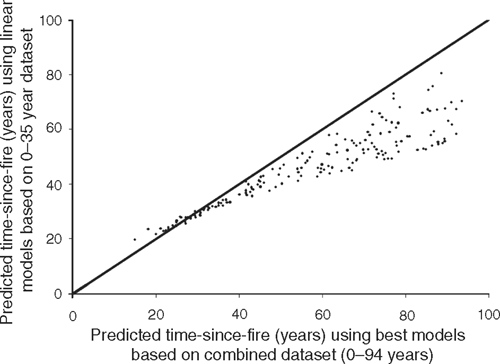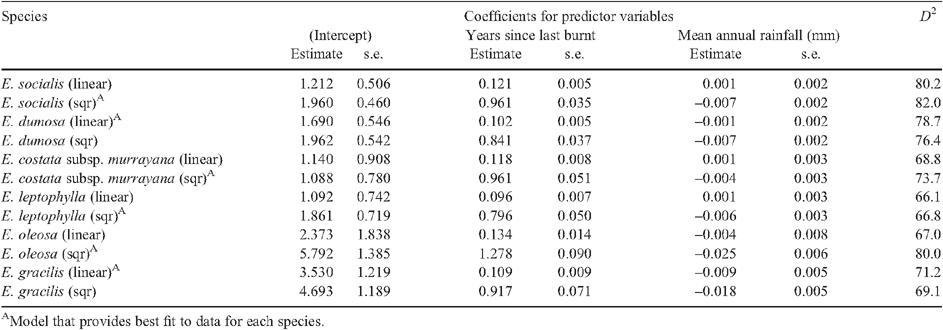Ageing mallee eucalypt vegetation after fire: insights for successional trajectories in semi-arid mallee ecosystems
Michael F. Clarke A D , Sarah C. Avitabile A , Lauren Brown A , Kate E. Callister A , Angie Haslem A B , Greg J. Holland B , Luke T. Kelly B , Sally A. Kenny C , Dale G. Nimmo B , Lisa M. Spence-Bailey A , Rick S. Taylor A , Simon J. Watson B and Andrew F. Bennett BA Department of Zoology, La Trobe University, Bundoora, Vic. 3086, Australia.
B School of Life and Environmental Sciences, Deakin University, Burwood, Vic. 3125, Australia.
C Department of Botany, La Trobe University, Bundoora, Vic. 3086, Australia.
D Corresponding author. Email: m.clarke@latrobe.edu.au
Australian Journal of Botany 58(5) 363-372 https://doi.org/10.1071/BT10051
Submitted: 19 February 2010 Accepted: 14 May 2010 Published: 21 July 2010
Abstract
A critical requirement in the ecological management of fire is knowledge of the age-class distribution of the vegetation. Such knowledge is important because it underpins the distribution of ecological features important to plants and animals including retreat sites, food sources and foraging microhabitats. However, in many regions, knowledge of the age-class distribution of vegetation is severely constrained by the limited data available on fire history. Much fire-history mapping is restricted to post-1972 fires, following satellite imagery becoming widely available. To investigate fire history in the semi-arid Murray Mallee region in southern Australia, we developed regression models for six species of mallee eucalypt (Eucalyptus oleosa F.Muell. ex. Miq. subsp. oleosa, E. leptophylla F.Muell. ex. Miq., E. dumosa J. Oxley, E. costata subsp. murrayana L. A. S. Johnson & K. D. Hill, E. gracilis F.Muell. and E. socialis F.Muell. ex. Miq.) to quantify the relationship between mean stem diameter and stem age (indicated by fire-year) at sites of known time since fire. We then used these models to predict mean stem age, and thus infer fire-year, for sites where the time since fire was not known. Validation of the models with independent data revealed a highly significant correlation between the actual and predicted time since fire (r = 0.71, P < 0.001, n = 88), confirming the utility of this method for ageing stands of mallee eucalypt vegetation. Validation data suggest the models provide a conservative estimate of the age of a site (i.e. they may under-estimate the minimum age of sites >35 years since fire). Nevertheless, this approach enables examination of post-fire chronosequences in semi-arid mallee ecosystems to be extended from 35 years post-fire to over 100 years. The predicted ages identified for mallee stands imply a need for redefining what is meant by ‘old-growth’ mallee, and challenges current perceptions of an over-abundance of ‘long-unburnt’ mallee vegetation. Given the strong influence of fire on semi-arid mallee vegetation, this approach offers the potential for a better understanding of long-term successional dynamics and the status of biota in an ecosystem that encompasses more than 250 000 km2 of southern Australia.
Acknowledgements
We gratefully acknowledge funding and support for this project from Parks Victoria, Department of Sustainability and Environment (Vic.), Mallee Catchment Management Authority, NSW National Parks and Wildlife Service, Department of Environment and Climate Change (NSW), Lower Murray–Darling Catchment Management Authority, Department for Environment and Heritage (SA), Land and Water Australia, Natural Heritage Trust, Birds Australia (Gluepot Reserve), Australian Wildlife Conservancy (Scotia Sanctuary) and the Murray Mallee Partnership. We are grateful to the University of Ballorat and to the Doyle and Barnes families for granting access to Nanya, Petro and Lethero Stations, respectively. Thanks go to Lauren Fraser for assistance with references and many volunteers who assisted with vegetation surveys and to Martin Westbrooke and Simon Cook who directed us to many of the validation sites. We are also very grateful for the constructive suggestions of two anonymous referees.
Barker S
(1988) Population structure of snow gum (Eucalyptus pauciflora Sieb. ex Spreng.) subalpine woodland in Kosciusko National Park. Australian Journal of Botany 36, 483–501.
| Crossref | GoogleScholarGoogle Scholar |

Bond WJ,
Woodward FI, Midgley GF
(2005) The global distribution of ecosystems in a world without fire. New Phytologist 165, 525–538.
| Crossref | GoogleScholarGoogle Scholar |
CAS |
PubMed |

Bos DG, Carthew SM
(2003) The influence of behaviour and season on habitat selection by a small mammal. Ecography 26, 810–820.
| Crossref | GoogleScholarGoogle Scholar |

Bowman D,
Balch JK,
Artaxo P,
Bond WJ,
Carlson JM,
Cochrane MA,
D’Antonio CM,
DeFries RS,
Doyle JC,
Harrison SP,
Johnston FH,
Keeley JE,
Krawchuk MA,
Kull CA,
Marston JB,
Moritz MA,
Prentice IC,
Roos CI,
Scott AC,
Swetnam TW,
van der Werf GR, Pyne SJ
(2009) Fire in the earth system. Science 324, 481–484.
| Crossref | GoogleScholarGoogle Scholar |
CAS |
PubMed |

Bradstock RA,
Bedward M,
Gill AM, Cohn JS
(2005) Which mosaic? A landscape ecological approach for evaluating interactions between fire regimes, habitat and animals. Wildlife Research 32, 409–423.
| Crossref | GoogleScholarGoogle Scholar |

Brockett BH,
Biggs HC, van Wilgen BW
(2001) A patch mosaic burning system for conservation areas in southern African savannas. International Journal of Wildland Fire 10, 169–183.
| Crossref | GoogleScholarGoogle Scholar |

Brown S,
Clarke M, Clarke R
(2009) Fire is a key element in the landscape-scale habitat requirements and global population status of a threatened bird: the mallee emu-wren (Stipiturus mallee). Biological Conservation 142, 432–445.
| Crossref | GoogleScholarGoogle Scholar |

Burrows ND
(2008) Linking fire ecology and fire management in south-west Australian forest landscapes. Forest Ecology and Management 255, 2394–2406.
| Crossref | GoogleScholarGoogle Scholar |

Clarke MF
(2008) Catering for the needs of fauna in fire management: science or just wishful thinking? Wildlife Research 35, 385–394.
| Crossref | GoogleScholarGoogle Scholar |

Clarke RH,
Boulton RL, Clarke MF
(2005) Estimating population size of the black-eared miner, with an assessment of landscape-scale habitat requirements. Pacific Conservation Biology 11, 174–188.

Driscoll DA, Henderson MK
(2008) How many common reptile species are fire specialists? A replicated natural experiment highlights the predictive weakness of a fire succession model. Biological Conservation 141, 460–471.
| Crossref | GoogleScholarGoogle Scholar |

Fox BJ,
Taylor E, Thompson PT
(2003) Experimental manipulation of habitat structure: a retrogression of the small mammal succession. Journal of Animal Ecology 72, 927–940.
| Crossref | GoogleScholarGoogle Scholar |

Friend GR
(1993) Impact of fire on small vertebrates in mallee woodlands and healthlands of temperate Australia. Biological Conservation 65, 99–114.
| Crossref | GoogleScholarGoogle Scholar |

Holland PG
(1969) Weight dynamics of Eucalyptus in the mallee vegetation of southeast Australia. Ecology 50, 212.
| Crossref | GoogleScholarGoogle Scholar |

Letnic M,
Dickman CR,
Tischler MK,
Tamayo B, Beh CL
(2004) The responses of small mammals and lizards to post-fire succession and rainfall in arid Australia. Journal of Arid Environments 59, 85–114.
| Crossref | GoogleScholarGoogle Scholar |

Lindenmayer DB,
MacGregor C,
Welsh A,
Donnelly C,
Crane M,
Michael D,
Montague-Drake R,
Cunningham RB,
Brown D,
Fortescue M,
Dexter N,
Hudson M, Gill AM
(2008) Contrasting mammal responses to vegetation type and fire. Wildlife Research 35, 395–408.
| Crossref | GoogleScholarGoogle Scholar |

Lunt ID
(2002) Grazed, burnt and, cleared: how ecologists have studied century-scale vegetation changes in Australia. Australian Journal of Botany 50, 391–407.
| Crossref | GoogleScholarGoogle Scholar |

Noble JC, Vines RG
(1993) Fire studies in mallee (Eucalyptus spp.) communities of western New South Wales: grass fuel dynamics and associated weather patterns. The Rangeland Journal 15, 270–297.
| Crossref | GoogleScholarGoogle Scholar |

Noble JC,
Smith AW, Leslie HW
(1980) Fire in the mallee shrublands of western New South Wales. The Rangeland Journal 2, 104–114.
| Crossref | GoogleScholarGoogle Scholar |

Ogden J
(1978) On the dendrochronological potential of Australian trees. Austral Ecology 3, 339–356.
| Crossref | GoogleScholarGoogle Scholar |

Parr CL, Andersen AN
(2006) Patch mosaic burning for biodiversity conservation: a critique of the pyrodiversity paradigm. Conservation Biology 20, 1610–1619.
| Crossref | GoogleScholarGoogle Scholar | PubMed |

Pausas JG, Bradstock RA
(2007) Fire persistence traits of plants along a productivity and disturbance gradient in mediterranean shrublands of south-east Australia. Global Ecology and Biogeography 16, 330–340.
| Crossref | GoogleScholarGoogle Scholar |

Rumpff L,
Cutler SC,
Thomas I, Morgan JW
(2009) An assessment of the relationship between tree-ring counts and basal girth of high-altitude populations of Eucalyptus pauciflora (Myrtaceae). Australian Journal of Botany 57, 583–591.
| Crossref | GoogleScholarGoogle Scholar |

Torre I, Diaz M
(2004) Small mammal abundance in Mediterranean post-fire habitats: a role for predators? Acta Oecologica 25, 137–142.
| Crossref | GoogleScholarGoogle Scholar |


|




